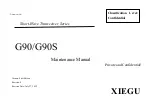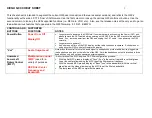
General
Antenna selection
Antenna
Transceiver and tuner mounting
Ground (earth) system
Marine Installations
The Barrett 911 automatic antenna tuner is designed for use in land base station and
maritime HF services. Primarily designed for operation with end-fed un-balanced antennas
such as whips and long wires, the tuner is built in a waterproof impact resistant, moulded
ABS plastic enclosure.
The 911 automatic antenna tuner will operate into almost any end-fed antenna with a length
exceeding 2.5 metres, providing an effective ground (earth) is used. The antenna efficiency
will be proportional to the length of the antenna and will be maximum when the length of the
antenna approaches 1/4 wavelength. It is advisable to limit the wire antenna to 1/4 or 3/4
wavelength at the highest frequency to be used.
On sailing vessels the antenna can either be an insulated backstay or a whip antenna
mounted vertically, usually on the stern. Best performance will be achieved by using an
insulated backstay as the radiating length will be longer than that available when using a
whip. The top insulator on the backstay should be approximately 300 mm from the mast and
the bottom insulator should be at eye level above the deck. The distance between insulators
should be greater than 10 metres and less than 35 metres. A whip antenna is generally
used on small to medium sized power vessels. There are different length whips to suit the
vessel length.
Select a suitable position in the vessel to mount the transceiver. It should be a position that
is out of the weather and easily accessible to the operator, whilst as close as practical to the
13.8V DC power source. Mount the transceiver to a solid fixing point using the mounting
cradle. Make sure there is sufficient space at the rear of the transceiver to connect the
power and antenna cables.
The antenna tuner should be mounted as close to the antenna feed point as possible. In
metal vessels the length of the feeder from the antenna tuner to the feed-through insulator,
inside the vessel, should be kept less than 1 metre.
The antenna feed cable should be a suitable high voltage cable. Care should be taken to
avoid sharp points when terminating the cable to prevent corona discharges.
The interconnect cable supplied with the antenna tuner should be routed away from other
cables back to the transceiver and connected as indicated in the diagram overleaf.
The ground (earth) system is a key part of the overall antenna system and consequently the
system operation. An inadequate ground system is the primary cause of poor performance
and tuning problems. There is little point in installing the antenna unless a good ground
system can be provided.
BARRETT 950 HF TRANSCEIVER
PAGE 121
















































